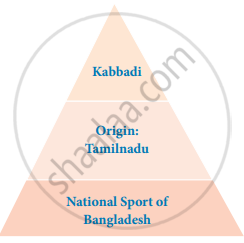Advertisements
Advertisements
Question
Explain the contradiction in the similies, ‘Like a child from the womb, like a ghost from the tomb’.
Solution
A child from the womb signifies the birth, a new beginning whereas the ghost from the tomb is in contrast, implying death or the end.
APPEARS IN
RELATED QUESTIONS
How did Helen Keller enjoy her visit to the World fair? (120‒150 words)
Attempt a character sketch of Squire Cass.
Discuss the following statement in groups of two pairs, each pair in a group taking opposite points of view.
A single event may change the course of the history of a nation.
What is the central argument of the speaker?
Expand the idea inherent in the following proverb :
Fools rush in where angels fear to tread - Alexander Pope.
Read aloud the account of how Flying Officer Nirmal Jit Singh Sekhon sacrificed his life to defend our country.
Describe the following with the help of the story.
The fabric is woven by Thiruvalluvar
Correct the given sentence with justification.
The play is restricted to only a part of the woods.
State whether the following statement is True or False:
Both Demetrius and Lysander fight for Hermia.
Explain the meaning of the following phrase:
An eagle’s eye
Antonio had gone on a long voyage.
Add ten more words to the list on your own. Each of the component words must be meaningful.
Read the poem : ‘Where lies the land...’ by A. C. Clough.
Use the following outline to develop a story as a group activity. Then write the story individually.
Family returns home late at night ______ hear converstation between thieves from inside the locked house ______ family gets ready to counter ______ attack ______ father opens the door ______ all enter ______ no one is seen ______ but TV is on detective serial midway.
What plans did the wife make?
List the insects, birds, trees and plants mentioned in the poem.
List the characters in the story and write a few lines about each of them.
Which event in the story tells us that the lion was brave?
Where did Chulong catch the bird?
The author was going to New York.
Two scary events from this section are listed here. Write the events that take place in between in the correct order.

Read the line and answer the question.
And all I ask is a merry yarn from a laughing fellow rover.
What kind of human company does the poet want?
Read these lines and answer the question given below.
How cheerful he seems to grin
Who does ‘he’ refer to?
Mother called ______.
What word could best replace ‘charges’ in the poem - marches, rushes or pushes?
We don’t use _________ in the soil.
Look at the picture and Choose the correct word.

How were her strokes?
Answer the following yes or no question.
Did Appu share guava?
The passage given below is on Kabbadi. Read the passage and complete the activities that follow.
Kabbadi (கபடி - in Tamil) is a contact team sport that originated in Tamil Nadu, India. It is the national sport of Bangladesh. It is also popular in South Asia and is the state game of the Indian states of Tamil Nadu, Kerala, Andhra Pradesh, Bihar, Haryana, Karnataka, Maharashtra, Punjab, and Telangana.

Kabbadi is played between two teams of seven players: the objective of the game is for a single player on offence referred to as a 'raider', to run in to the opposing teams half of a court, tag out as many of their defenders as possible, and return to their own half of the court–all without being tackled by the defenders. Points are scored for each player tagged by the raider, while the opposing team earns a point for stopping the raider. Players are taken out of the game if they are tagged or tackled, but can be 'revived' for each point scored by their team from a tag or tackle. The raider should hold his breath and utter the words like 'kabbadi kabbadi, hututu hututu, chadu kudu' etc. while the opponents try to catch him. If he stops uttering these words, he is considered out.
The game is known by its regional names in different parts of the subcontinent, such as Kabbadi or Chedugudu in Andhra Pradesh, Kabbadi in Kerala and Telangana, Hadudu in Bangladesh, Bhavatik in Maldives, Kauddi or Kabbadi in the Punjab Region, Hu-Tu-Tu in Western India and Hu-Do-Do in Eastern India and Chadakudu in South India. The highest governing body of Kabbadi is the International Kabbadi Federation.
Given below is the visual presentation of the first paragraph.

i) Represent the other paragraphs in a visual form of your choice(flow chart, mind-map, pie-chart, etc.).
ii) Choose the correct option.
1. A contact sport usually involves a ______contact between players.
- violent
- gentle
- physical
2. Kabbadi is a game played between ______.
- seven teams of two players
- two teams of seven players
- four teams of seven players
3. A single ______.
- player on offence is referred to as a raider
- offence is referred to as a raider
- raider is an offence by the player
iii) Answer the following.
- How does a raider score points for his team?
- When does a raider concede a point to the opponent team?
- Can a player be revived when he/she is out of the game? Explain your answer.
- Kabbadi is called by different names in different parts of India. Do you know how Pallankuzhi is called in Karnataka, Andhra Pradesh and Kerala?
